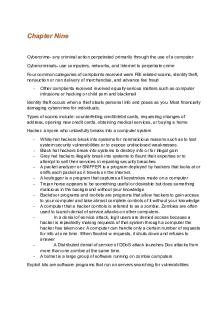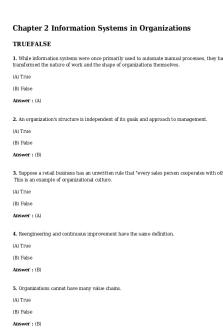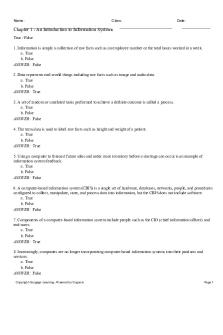Introduction to Information Technology PDF

| Title | Introduction to Information Technology |
|---|---|
| Course | Managing Information with Technology |
| Institution | Brunel University London |
| Pages | 11 |
| File Size | 435.8 KB |
| File Type | |
| Total Downloads | 102 |
| Total Views | 166 |
Summary
Introduction to Information Technology:...
Description
Introduction to Information Technology: The Future Now UNIT 1A: The Mobile World, Information, & Your Life •
As the result of developments in information technology, smartphones and tablet computers are changing nearly everything we do.
•
Information technology refers to any technology that helps produce, manipulate, store, communicate, and/or disseminate information.
Two Parts of IT: Computers & Communications Information technology affects almost all aspects of our lives, including education, health, finance, recreation and entertainment, government, jobs and careers, and your personal life. •
Part 1: Computer Technology
A computer is a programmable, multiuse machine that accepts data—raw facts and figures—and processes, or manipulates, it into information we can use. •
Part 2: Communications Technology
Communications technology, also called telecommunications technology, consists of electromagnetic devices and systems for communicating over any distance. Education: The Promise of More Interactive & Individualized Learning Education has become heavily involved in information technology. •
•
Information technology can be used for: •
Personalizing students’ education
•
Automating tedious and rote tasks and managing classes
•
Reducing instructors’ workload (course-management software)
•
Graphical presentations (e.g., PowerPoint)
What is misuse? •
Text messaging or emailing friends during class
•
Surfing the Internet for entertainment
•
Doing assignments for other classes
•
Sharing answers
Education: The Promise of More Interactive & Individualized Learning •
Online Learning, or distance learning, is becoming common. •
Not all online schools/courses are accredited; students should check.
of
•
Online courses are less expensive than traditional courses.
•
Distance learning is available to students in rural areas.
•
Tutoring, simulation, and avatars are also aspects of IT in education:
Health: High-Tech for Wellness Computers are playing important roles in our personal lives. •
Telemedicine: Medical care via telecommunications lets doctors treat patients from far away.
•
3D Computer models allow accurate tumor location inside a skull; X rays, MRIs, CT scans can be done remotely.
•
Robots—automatic devices that perform functions
•
ordinarily performed by human beings—permit precise microsurgery.
•
Health websites provide medical information.
•
Many health records are stored electronically.
Money & Business: Toward the Cashless Society? Information technology is reducing the use of traditional money. •
Virtual means something that is created, simulated, or carried on by means of a computer or a computer network.
•
Virtual money includes cash-value cards, automatic transfers, and digital money •
“Electronic wallets” (e.g., PayPal)
•
Electronic payroll deposit
•
Online bill paying via debit and credit cards
•
Micropayments for online products and to help charities
•
Smartphones are used for “showrooming” and shopping.
•
Technology can also be used to telecommute and to start businesses and earn money.
Government & Electronic Democracy: Participating in the Civic Realm Information technology is helping governments to deliver services and is affecting political activism. •
IT can help governments to improve services, including police services, which use databases, computer systems with a collection of interrelated files.
•
Online voting is becoming common.
•
Information is easier to disseminate.
•
Watchdog websites are growing.
•
Easier fund raising from small donors.
BUT: •
Gerrymandering is becoming easier—redrawing voting districts for partisan advantage.
•
Voting machine problems can occur.
•
Invasion of privacy is becoming an important issue.
Jobs & Careers People now use computers to post résumés and find jobs. •
IT is used in starting new business ventures.
•
IT is used to prepare résumés and find jobs on many websites.
To help find jobs, participate in social media and write comments on blogs (weblogs), frequently updated sites on the web intended for public consumption that contain a writer’s observations, opinions, images, and links to other websites. •
Basic computer skills are needed for most jobs: •
Know how to use a keyboard.
•
Use email.
•
Be able to use a word processor (usually Microsoft Word).
•
Know basic spreadsheet and database software skills.
•
Understand the basics of file sizes, computer memory limitations, and network arrangements.
•
Know what the basic computer system components are.
Your Personal Life: Computers are playing important roles in our personal lives. •
Online relationship sites, or online dating sites, provide electronic forums that people may join in the hope of meeting compatible companions or mates.
•
“Digital is embedded into the fiber of every aspect of our culture and our personal lives”– public safety and security; in the home; entertainment; finance; communications; traveling; shopping; medical care; and so on.
1.2 Information Technology Is Pervasive The Phone Grows Up The telephone is not what it used to be. •
1973: First cellphone call
•
Mobile phone use estimated to rise to 7 billion users in 2014
•
Today’s smartphones can: •
Make voice calls
•
Connect to Internet and web for all sorts of activities
•
Send and receive text messages
•
Take and send pictures and download music and video
•
Obtain news and TV programs
•
Scan special barcodes that take users to a website
•
Provide maps
•
Do research
•
Pay for products and services
The Internet, the World Wide Web, & the “Plumbing” of Cyberspace The net, the web, and cyberspace are not the same things. •
Cyberspace •
Term coined by William Gibson in Neuromancer
(1984) to describe a futuristic computer network people “plugged” their brains •
into directly with
Now the term cyberspace encompasses not only the online world and the Internet in particular but also the whole wired and wireless world of communications in general.
The Net & Web Defined The Internet (the “Net” or “net”) is a worldwide computer network that connects hundreds of thousands of smaller networks. These networks link educational, commercial, nonprofit, and military entities, as well as individuals. The World Wide Web (the “Web” or the “web” is an interconnected system of Internet computers (called servers ) that support specially formatted documents in multimedia form. (The word multimedia, from “multiple media,” refers to technology that presents information in more than one medium, such as text, still images, moving images, and sound.) UNIT 1B: The Basics of Information Technology •
As the result of developments in information technology, smartphones and tablet computers are changing nearly everything we do.
•
Information technology refers to any technology that helps produce, manipulate, store, communicate, and/or disseminate information.
1.3 The Practical User Being informed about information technology has practical payoffs.
•
Know how to make better buying decisions
•
Know how to fix ordinary computer problems
•
Know how to upgrade equipment and integrate it with new products
•
Know how to use the Internet effectively
•
Know how to guard against online dangers
•
Know how computer knowledge can advance your career
1.4 The “All-Purpose Machine” All Computers, Great & Small: The Categories of Machines Computers come in different sizes; they also function as clients and/or servers. •
There are five basic computer sizes.
1. Supercomputers 2. Mainframes 3. Workstations 4. Microcomputers 5. Microcontrollers 1. Supercomputers Supercomputers are used in very special situations. • Priced from $1 million to over $350 million. • High-capacity machines with thousands of processors that can perform more than several quadrillion calculations per second. • Faster and largest computer available. • Used for government census, weather forecasting, designing aircraft, scientific projects, etc. • The Titan (U.S.A.) computer is currently the largest supercomputer. • The next supercomputer generation may use nanotechnology. 2. Mainframes Mainframe computers are used in many large businesses. • Priced from $5,000 to $5 million • Process billions of instructions per second • Size is dependent on the use • Water-cooled or air-cooled • Used to be called midsize computers • Used by banks, airlines, colleges, and the like for millions of transactions 3. Workstations Workstations are used for graphics, special effects, and certain professional applications. • Expensive, powerful personal computers
• • •
Used for scientific, mathematical, engineering, computer-aided design (CAD), computer-aided manufacturing (CAM) applications Used for designing cars, drugs, movie special effects Are usually connected to a network
4. Microcomputers Microcomputers are used by individuals as well as businesses, and they can be connected to networks of larger computers. There are many types of microcomputers. •
Personal computers that cost $500 to over $5,000
•
Used either stand-alone or in a network
•
Types include: desktop, tower, notebooks (laptops), netbooks, tablets, mobile devices, personal digital assistants (PDAs), and e-readers
Servers: •
The word server describes the way a computer— whether mainframe, workstation, or PC—is used.
•
A server, or network server , is a central computer that holds collections of data (databases) and programs for connecting or supplying services to PCs, workstations, and other devices, which are called clients. These clients are linked by a wired or wireless network. The entire network is called a client-server network.
•
Purpose: Hold data and programs for clients to access and to supply services for clients.
1.5 Understanding Your Computer How Computers Work: Three Key Concepts All computer users must understand three basic principles: (1) Data is turned into information; (2) hardware and software have their own specific functions; and (3) all computers involve input, processing, storage, and output, plus communications. 1. Purpose of a computer: Turning data into information •
Data: the raw facts and figures
•
Information: data that has been summarized or otherwise transformed for use in decision making
2. Hardware vs. software •
Hardware = the machinery and equipment in a computer system
•
Software (programs) = the electronic instructions that tell the computer how to perform a task
3. The basic operations of a computer: All computers use 4 basic operations + communications: •
Input: What goes into the computer system
•
Processing: The manipulation a computer does to transform data into information
•
Storage: •
Primary storage, or memory, is temporary storage for data waiting to be processed
•
Secondary storage is permanent storage: media such as hard disk, DVDs, and CDs
•
Output: What comes out—the results of processing, such as on the screen, printouts, sound
•
Communications: Sending and receiving data
Customizing a Desktop Computer •
•
What would you need? •
Keyboard & mouse (input hardware)
•
Inside the system cabinet (processing & memory hardware) •
Case and power supply
•
Processor chip – the central processing unit (CPU)
•
Memory chips – random access memory (RAM) or primary storage
•
Motherboard – the system board, the main circuit board, with expansion slots to plug in components
Storage Hardware: Hard Drive, CD/DVD Drive •
Storage capacity is represented in bytes •
1 byte = 1 character of data
•
1 kilobyte = 1,024 characters
•
•
•
1 megabyte = 1,048,576 characters
•
1 gigabyte = over 1 billion characters
•
1 terabyte = over 1 trillion characters
•
1 petabyte = about 1 quadrillion characters
Output hardware •
Video
•
Sound cards
•
Speakers
•
Monitor
•
Printer
Communications hardware •
Modem
Basic PC System
Software Computers use two basic types of software: system software and application software. •
System Software—enables the computer to perform essential operating tasks and makes it possible for application software to run. •
Most important part: operating system (OS)
•
Some operating system options •
Windows
•
•
Unix
•
Linux
•
Mac OS
Application Software—enables you to perform specific tasks—solve problems, perform work, or entertain yourself. •
Compatibility: Application software is specific to the system software you use. •
Linux applications won’t work on Windows.
•
Windows applications won’t necessarily work on Linux.
1.6 Where Is Information Technology Headed?
When Computers & Communications Converge: Five Results Convergence—combination of several industries •
Computers
•
Communications
•
Consumer electronics
•
Entertainment
•
Mass media
1. Portability 2. Personalization 3. Collaboration
4. Cloud computing 5. Artificial intelligence Cloud computing basically means that instead of storing your software and/or data on your own PC or your own company’s computers, you store it on servers on the Internet. Artificial intelligence (AI) refers to a group of related technologies used for developing machines to emulate human qualities, such as learning, reasoning, communicating, seeing, and hearing. Much of AI is based on the use of algorithms, formulas or sets of steps for solving particular problems. AI deals with Big Data, data that is so large and complex that it cannot be processed using conventional methods, Ethics: Many important ethical issues are involved in the use of information technology. •
Ethics is the set of moral values or principles that govern the conduct of an individual or a group.
•
3 ethical considerations resulting from development of IT: •
Speed & scale affect security and personal privacy
•
Unpredictability—IT can be less predictable and reliable than other technologies
•
Complexity—computer systems can be unmanageable...
Similar Free PDFs

Introduction to dairy technology
- 31 Pages

Introduction to Web Technology
- 12 Pages

Information Technology Sourcing
- 5 Pages

information technology IT2019
- 3 Pages

Information Technology Business PLAN
- 10 Pages

Information Technology (MIS)
- 68 Pages
Popular Institutions
- Tinajero National High School - Annex
- Politeknik Caltex Riau
- Yokohama City University
- SGT University
- University of Al-Qadisiyah
- Divine Word College of Vigan
- Techniek College Rotterdam
- Universidade de Santiago
- Universiti Teknologi MARA Cawangan Johor Kampus Pasir Gudang
- Poltekkes Kemenkes Yogyakarta
- Baguio City National High School
- Colegio san marcos
- preparatoria uno
- Centro de Bachillerato Tecnológico Industrial y de Servicios No. 107
- Dalian Maritime University
- Quang Trung Secondary School
- Colegio Tecnológico en Informática
- Corporación Regional de Educación Superior
- Grupo CEDVA
- Dar Al Uloom University
- Centro de Estudios Preuniversitarios de la Universidad Nacional de Ingeniería
- 上智大学
- Aakash International School, Nuna Majara
- San Felipe Neri Catholic School
- Kang Chiao International School - New Taipei City
- Misamis Occidental National High School
- Institución Educativa Escuela Normal Juan Ladrilleros
- Kolehiyo ng Pantukan
- Batanes State College
- Instituto Continental
- Sekolah Menengah Kejuruan Kesehatan Kaltara (Tarakan)
- Colegio de La Inmaculada Concepcion - Cebu



![OBrien - Introduction to Information Systems [2010]](https://pdfedu.com/img/crop/172x258/zx28ke2j06rw.jpg)





